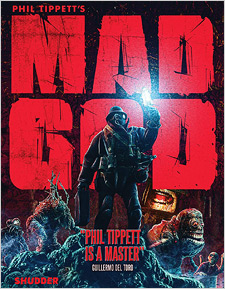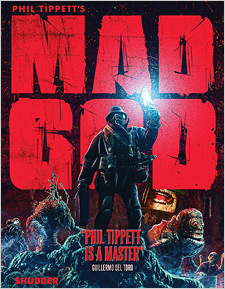Mad God – Limited Edition Steelbook (Blu-ray Review)

Director
Phil TippettRelease Date(s)
2021 (December 6, 2022)Studio(s)
Tippett Studio (Shudder)- Film/Program Grade: A
- Video Grade: A-
- Audio Grade: A+
- Extras Grade: B
Review
Holy fuck.
There are, of course, a multitude of reactions that one can have upon seeing Phil Tippett’s Mad God, but those are certainly the first two words that came to my mind as its credits rolled to the cheery sounds of Neusidler’s Gassenhauer. Hands down, this is the weirdest film I’ve seen in all my fifty-five years of cinema viewing. Yet it’s also amazing. And once you’ve survived its grotesque pageantry, the experience is strangely uplifting as well.
To the extent that there’s a story here, it goes something like this: In a bleak and post-apocalyptic hellscape, a gas-masked Assassin makes a grueling, psychonautical descent into a nightmarish and multilayered underworld of tortured souls, oozing horrors, and festering biomechanical absurdities, riding his battered bathyscaphe ever deeper through a surreal and hallucinogenic symphony of gooey, stop-motion monstrosities.
Conceived, produced, and directed by Tippett—the practical-effects artist behind the animated chessboard in Star Wars, the tauntauns and AT-ATs of The Empire Strikes Back, the 400-year-old Vermithrax Pejorative of Dragonslayer, and OCP’s ED-209 enforcer from RoboCop—over the course of three decades and with the help of volunteer animators at Tippett Studio, fellow ILM alum Dennis Muren, students from Academy of Art University in San Francisco, and the financial support of a wildly-successful Kickstarter campaign, Mad God is a singular work of both genius and madness.
Blending stop and go-motion with traditional puppetry, time-lapse photography, live action, and a host of other old-school cinematic illusion techniques, the film’s intricate and meticulously-weird production design references H.R. Giger, Wayne Barlowe, Karel Zeman, Dante Alighieri, John Milton, Ray Harryhausen, H.P. Lovecraft, Ralph Bakshi, Jim Henson, Pieter Bruegel, Alejandro Jodorowsky, Hieronymus Bosch, Terry Gilliam, Stanley Kubrick, even Bob Dylan, all of it fed like steaming meat though the grinder of Tippett’s unique creative sensibilities. The result is a deeply personal exploration of—and commentary on—creation, evolution, life, civilization, despair, destruction, and renewal, not to mention the artist’s own unconscious mind. Think Lewis Carroll’s Alice in Wonderland meets Stan Brakhage’s The Act of Seeing with One’s Own Eyes, but thirty years in the making. This is a twisted Möbius strip of a masterpiece. (Be sure to watch for a cameo by filmmaker Alex Cox (Repo Man, Sid & Nancy) as the Last Man.)
A little bit of Mad God was shot on 35 mm film, but most of it was digital photographed. The film was finished at the 1.85:1 aspect ratio and is presented on disc at 1.78:1 so as to fill your frame with horrors. Clarity is excellent for HD, with plenty of exquisite texturing and detail. (That’s important because Mad God thrives in its textures.) Colors are bold by design and richly saturated, at least as much as 10-bit SDR can allow. Shadows are deep, but lots of atmospherics have been employed here, so don’t expect too much detail in the depths. Still, what you need to see is there. The highlights are bright and the contrast between the two is striking. This is a lovely HD image, on the whole. But if ever there was a film that deserved a 4K Ultra HD release with HDR, this is it.
Sound is available in 5.1 DTS-HD Master Audio. Technically it’s in English, but there’s very little dialogue here. The mix is by turns subtle and chaotic, a sonic blizzard of weird little organic sounds, movements, and directionally. The sense of immersion, of atmosphere, and sheer spatial environment is remarkable. Every bit as good is the score by composer Dan Wool, which tends toward the subtle, evoking Dylan with a bit of acoustic guitar here, children’s instruments there, wind chimes, music boxes, and what sounds occasionally like found objects elsewhere, all of it lightly melodic yet slightly atonal in a way that recalls the work of Ennio Morricone. The aforementioned Gassenhauer also appears, along with a bit of choral music and tracks by Berlioz and Strauss. Bass is firm though never blustery. The sonic experience of Mad God is as delightful as it is utterly unique. Optional English SDH subtitles are also included.
Shudder’s Blu-ray release is a 2-disc set with the film in 1080p HD on Blu-ray and also SD on a regular DVD. Both contain the following extras (in SD only on DVD obviously):
- Commentary with Phil Tippett and Guillermo Del Toro
- Cast & Crew Commentary
- Interview with Phil Tippett (HD – 4:38)
- Mad God Influences & Inspirations (HD – 6:33)
- Maya Tippet’s The Making of Mad God (HD – 10:19)
- Maya Tippett’s Worse than the Demon (HD – 12:33)
- Academy of Art University & Mad God (HD – 5:14)
- Mad God Behind-the-Scenes Montage (HD – 12:32)
- Behind-the-Scenes Photo Gallery (HD – 2:15)
The highlight of the extras is the commentary with Tippett and filmmaker Guillermo Del Toro (Pan’s Labyrinth, The Shape of Water). I can’t imagine anyone better equipped to dive into this project than Del Toro, and he certainly doesn’t disappoint. Essentially, he interviews Tippett and asks all of the questions you’d want to ask yourself. There’s a mutual respect here, and an artistic shorthand, that really lends itself to a deep thematic discussion of the material and the process of making it.
The second commentary features Tippett joined by Wool, sound mixer Richard Beggs, cinematographer Chris Morley, animator Tom Gibbons, fabricator Kayte Sabicer, and editor Ken Rogerson to discuss the production. It’s more technically focused, but is no less interesting for it.
There’s a brief audio interview with Tippett, set to B&W behind-the-scenes footage, where he talks about what he intended Mad God to be. There’s a second short featurette where he comments on the origins of (and the many and varied influences on) the project. A piece directed by Tippett’s daughter Maya interviews many of the key volunteers who helped him to complete the project. Maya also interviews her father about the creative “demons” that drive him, both personally and creatively. This is really a kind of intimate profile of the artist and his origins, as seen by and revealed to someone close to him. There’s also a piece on the collaboration between the project and Academy of Art University, a moody behind-the-scenes montage, and a gallery of behind-the-scenes images. There’s no Digital copy, but both discs come in lovely Steelbook packaging with the Assassin character on the cover.
If stop-motion animation is indeed a dying art, then Mad God is its maniacal magnum opus, Phil Tippett’s raised-fist act of resistance—nay, defiance—against the dying of the light. This one sure as hell ain’t for the kiddies, and I suspect plenty of adults will squirm all the way through it too. It is certainly not going to appeal to everyone. But it’s also a film that cinephiles will be talking about for a very long time, and it’s absolutely recommended.
- Bill Hunt
(You can follow Bill on social media at these links: Twitter and Facebook)

